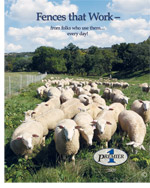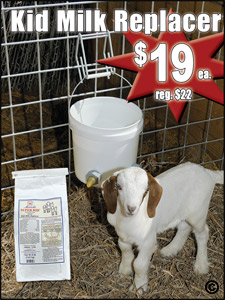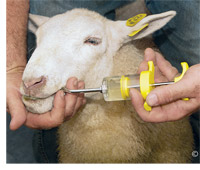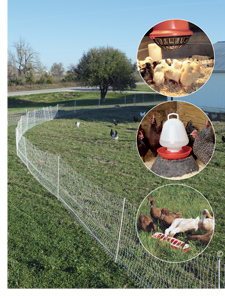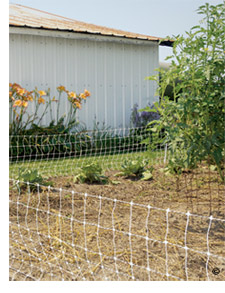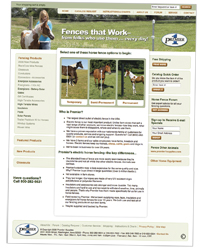Message from the Owner
Farm/Garden Size. Why small works…The number of small farms and gardens in the USA increases steadily—and the number of medium-size farms and gardens is shrinking. Why? This interests us at Premier as we consider taking the size of our own livestock farm operation up a notch. What are the critical advantages of the smaller farms?
Which brings us to the question—why do so many small, profitable, part-time operations run into trouble taking it to the next level—expanding the operation to medium-size? That's the subject for my next newsletter… Best wishes to you all. by Stan Potratz, Owner Now Available!
Fences That Work catalogNew Products
Reduced Prices
Click here to order our free catalog(s) Special Price from Premier!
Save $3 – Merrick™ Milk Replacer for KidsA proven milk replacer that consistently provides excellent results. Mixes completely in cold water with a vigorous stir with a wire whisk. Feed warm or cold either by hand or ad lib 2 lb. makes 1 gallon of milk. Merrick for Kids Order soon! Price good through April 30, 2009 or while supplies last!Premier Tip
Drenching 1 to 10 animalsHave a small-flock drencher on hand for those times when you only need to worm a few animals. This drencher is especially handy for those times that even after you have wormed your flock or herd, you see a few animals that show signs of parasites, which may be caused by an animal that spit out the drench or just one that you missed. There are also times that you only need to drench a ram or buck. In any case, having a small drencher on hand will be much easier than dragging out the auto drencher that takes longer to set up and clean than it does to worm a few animals. by Premier Sales Consultant, Gordon Shelangowski Premier Product
Need Poultry Supplies?"Backyard" poultry is booming. Premier has even started our own operation. To accommodate needs, we continue to identify and add products to assist in this venture. Includes heat lamps, feeders, waterers, netting, etc. View our complete line of poultry products. Premier VIP
How to Fence Your Spring Vegetable Garden to Keep out Animalsby thomasfence Cindy Thomas is co owner of Thomas Fence and Deck Company in Waukesha, WI. They have found the VersaNet system described below to be of great benefit to their customers. The cost of groceries today will encourage many people to plant a vegetable garden in their yard this year. One of the biggest problems with home gardening is keeping animals out of spring gardens. Being humane to animals and enjoying a bountiful summer harvest is goal #1. I recommend this cost-effective fence to achieve that goal. It's reusable, very easy to install, remove and store. It's environmentally sound and will pay you a significant return on your investment over its life. Things You'll Need: Step 1 - Determine what type of animals you wish to keep out of your spring garden. In the city you are dealing with small animals; in the country, larger animals. Based on your needs, visit Premier's website to order these supplies. Step 2 - Electric Fence is the most organically humane fence on the market. Why? Animals learn quickly to avoid pain. If done correctly, a small shock can protect an animal's life. This fence will not harm small animals or birds, but will stop them from raiding your garden. Step 3 - For homes in the city I recommend VersaNet 20, and in the country both VersaNet 30 and Deer QuikFence. These products are fully assembled and ready to use. Step 4 - You do not have to know anything about fencing to use these products. Premier offers a 3-minute and 15-minute training videos to watch on their website. Step 5 - Order the materials needed based on the lineal feet of your garden. Your lineal foot measurement will be the outside dimensions of your garden. Example: A 20 ft x 40 ft garden is 120 lineal ft. Step 6 - Install this product based on Premier's easy-to-follow instructions. These fences are as simple as push in and energize. Organize and plant your garden. Enjoy your garden all season long and for years to come. Step 7 - In the fall clear away dead foliage and collect your fence. Zip-tie it together and store for use in next year's garden. Step 8 - This unit will cost you on average $348 - $400. It should last a good 10 years before you will need to do repair or replacement. This means you will spend $40 a year to produce and protect $300 - $600 a year of fresh herbs and vegetables. Tips & Warnings
See the article online at www.ehow.com/members/thomasfence.html Horse Fences that Work
Premier's Horse Fence Websitewww.horsefencesthatwork.com
You can still visit www.premier1supplies.com for all species and products. Premier Employee Spotlight
Jodi WaterhouseJodi Waterhouse of Richland, Iowa, is this month's featured employee. She began working at Premier a year ago and assists in a number of departments. Jodi says, "I like it all." The best thing about Premier, she adds, is the family atmosphere. When asked her favorite saying, Jodi said, "It's all good." She added: "Because we have so much to be thankful for. No matter how bad our day is, we still have life and family. We have our health, and we have our freedom. We are blessed people and we take it for granted all the time. So instead of focusing on the bad of our day, we need to focus on the good." Her husband, Eric, works for an earth-moving and tiling company. Jodi enjoys doing freelance photography in her spare time. RecipeJalapeno Mint SauceEveryone loves this sauce and it's so easy to make! Serve warm or hot on lamb, chicken or pork. It's also delicious on baked potatoes and green peas. Ingredients: 1/4 cup sugar, or sugar substitute such as Splenda. Thoroughly rinse fresh, young mint and remove leaves from stems. Finely chop the leaves; discard stems. In a saucepan, combine vinegar, water and sugar and bring to a boil. Reduce heat. Add jalapeno jelly and stir until dissolved. Add chopped mint leaves. Simmer for 15 to 20 minutes to infuse. If consistency becomes too thick, add more water as needed. Makes about 1-1/2 cups of mint sauce. Store in refrigerator. Keeps for a month or more. Can be reheated in microwave. from Jean Potratz |



